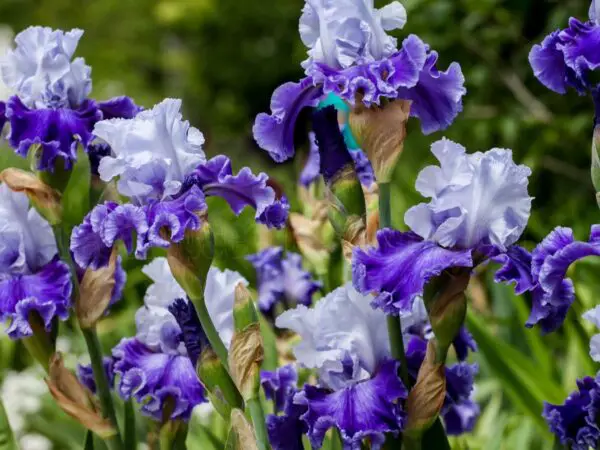Curious about the sycamore fig tree? This blog post will unravel the mysteries surrounding this iconic tree. While some may mistake it for a regular fig tree, there's a stark difference that sets the sycamore fig apart. Get ready to dive into the unique characteristics, ecological importance, and cultural significance of this fascinating species.
Join us on a journey through the intriguing world of sycamore fig trees as we explore their role in nature and human history. From their distinct appearance to their vital role as host trees in various ecosystems, these strangler figs have much to offer in terms of both beauty and survival. Discover why the sycamore fig stands out among its botanical peers.
Key Takeaways
- Understanding the botanical classification of sycamore fig trees helps appreciate their unique characteristics and significance in various cultures.
- The distinctive characteristics of sycamore fig trees, such as their large size, longevity, and spreading canopy, make them ecologically important and culturally significant.
- Sycamore fig trees hold deep cultural and symbolic value in many societies, reflecting their historical importance and spiritual connections.
- Recognizing the ecological role of sycamore fig trees highlights their contribution to biodiversity, ecosystem stability, and conservation efforts.
- Exploring the nutritional value and traditional uses of sycamore figs underscores their versatility as a food source and medicinal plant in different traditions.
- Engaging in gardening practices with sycamore fig trees can enhance landscapes, provide shade, and support local biodiversity while preserving these iconic trees.
Botanical Classification
Taxonomy
Sycamore fig trees, scientifically known as Ficus sycomorus, are part of the Moraceae family. These trees fall under the category of angiosperms, which means they produce flowers and fruits. The classification into the Moraceae family indicates that sycamore figs share characteristics with other plants in this botanical group.
The scientific name Ficus sycomorus is specific to sycamore fig trees. Their taxonomical placement within the angiosperms highlights their reproductive processes involving flowers and seeds. Being a member of the Moraceae family links them to various plant species sharing common traits.
Phylogeny
Belonging to the Ficus genus, which comprises over 800 diverse species worldwide, sycamore fig trees have a rich phylogenetic history. They are closely related to other varieties within the same genus like the common fig (Ficus carica). This close relation suggests similarities in genetic makeup and evolutionary paths between these different types of fig trees.
With an extensive evolutionary timeline spanning millions of years, sycamore fig trees have adapted uniquely over time. Originating in Africa, they showcase specialized features that enable them to thrive in varying environmental conditions. Their co-evolution with particular wasp species for pollination underscores their intricate ecological relationships.
Evolution
Evolved on the African continent, sycamore fig trees boast a long history marked by gradual adaptations to survive changing landscapes and climates effectively. Through this evolutionary journey, these trees have developed distinctive attributes tailored for their habitats' demands such as drought resistance or efficient nutrient absorption strategies.
The mutualistic relationship between sycamore figs and specific wasp species is crucial for successful reproduction through pollination mechanisms unique to these tree varieties. Over time, sycamore figs have honed survival tactics like root systems suited for arid environments or fruiting patterns synchronized with local wildlife behaviors.
Characteristics of the Tree
Description
Sycamore fig trees boast large and dark green leaves with prominent veins, providing ample shade and adding to their beauty. These leaves are not just visually appealing but also serve as valuable fodder for livestock due to their high nutritional value. Imagine these majestic trees standing tall, offering shelter under their lush canopy while nourishing animals with their nutritious foliage.
The inconspicuous flowers of sycamore fig trees are nestled within a unique structure known as a syconium. These flowers rely on specialized wasps for pollination, showcasing a fascinating mutualistic relationship in nature. Once successfully pollinated, the syconium transforms into fruits that can grow up to 2 inches long. The transition from green to yellow or purple signals ripeness, enticing both humans and wildlife with its sweet honey-like flavor when fully matured.
Distribution
Originating from Africa, sycamore fig trees thrive in tropical and subtropical regions across the continent where they find optimal conditions such as adequate rainfall and well-drained soil for growth. While native to Africa, these remarkable trees have ventured beyond their place of origin and now grace other parts of the world like the Middle East and select Mediterranean areas. Their ability to adapt has allowed them to spread far beyond their initial habitat.
- Sycamore fig trees have large dark green leaves.
- The tree's flowers develop within a syconium.
- Fruits turn yellow or purple when ripe.
- Native habitat includes African countries.
- Thrive in tropical regions with abundant rainfall.
Significance in Cultures
Role in Religion
The sycamore fig tree plays a vital role in various religions, such as Judaism and Christianity. In the Bible, it is specifically mentioned as the type of tree that Zacchaeus climbed to see Jesus. This act symbolizes seeking spiritual enlightenment and transformation. The sycamore fig holds deep-rooted meanings of humility, repentance, and metamorphosis within these faiths.
In ancient Egyptian mythology, sycamore fig trees were revered as sacred symbols associated with fertility and rebirth. They carried significant cultural importance beyond their physical presence. Moreover, in some African traditions, sycamores are viewed as protective entities that bring prosperity to those who honor them.
Sycamore fig trees have not only been pivotal in religion but have also made their mark on artistic expressions throughout history. Artists across different eras have captured the essence of these majestic trees through paintings, sculptures, and illustrations. Their distinctive leaves and fruits often serve as focal points for conveying messages related to nature's beauty and abundance.
Artists utilize sycamores symbolically to represent more profound connections to spirituality within their works of art. These depictions showcase how nature intertwines with human beliefs and emotions seamlessly.
Ecological Role
Ecosystem Benefits
Sycamore fig trees, also known as Ficus sycomorus, play a crucial role in the ecosystem by offering various benefits. Their expansive canopy provides essential shade, aiding in temperature regulation and reducing soil moisture loss. This dense foliage creates microclimates that support the growth of other plants beneath them. Sycamore fig trees help prevent erosion by stabilizing soil with their extensive root systems.
Furthermore, these majestic trees serve as vital habitats for numerous wildlife species. Birds and mammals heavily rely on sycamore figs as a source of food, ensuring biodiversity within their ecosystems. The presence of these trees fosters a delicate balance in nature, where different species coexist and depend on each other for survival.
Oldest Trees
Some sycamore fig trees have stood the test of time, living for centuries and earning the title of some of the oldest living beings on Earth. These ancient specimens can be found scattered across historical sites and nature reserves throughout Africa. Serving as silent witnesses to history's unfolding events, these long-lived trees embody resilience and endurance against the passage of time.
Nutritional Value
Nutrition Facts
Sycamore fig trees offer a variety of essential nutrients. Sycamore figs are packed with dietary fiber, which aids in digestion and helps maintain a healthy gut. They are abundant in vitamins and minerals such as potassium and calcium, crucial for various bodily functions.
These figs also contain natural sugars that provide a quick energy boost without the crash associated with processed sugars. Furthermore, sycamore figs possess high levels of antioxidants, which help combat oxidative stress in the body. By including sycamore figs in your diet, you can enhance its nutritional value significantly.
Sycamore fig trees play a vital role in promoting overall health due to their rich nutrient content. For instance, the dietary fiber found in these fruits supports healthy digestion by aiding regular bowel movements and preventing constipation. Moreover, the presence of vitamins like vitamin C boosts immunity and protects against illnesses.
Consuming sycamore figs is an excellent way to incorporate essential minerals like potassium into your diet; this mineral is crucial for maintaining proper heart function and regulating blood pressure levels. The antioxidants present in sycamore figs help reduce inflammation within the body, contributing to improved overall health.
Traditional Uses
Medicinal Uses
Various parts of the sycamore fig tree have been utilized in traditional medicine for their potential health benefits. Extracts from the bark and leaves are commonly used to address ailments such as diarrhea, skin infections, and respiratory issues. While these remedies have been passed down through generations since ancient times, further scientific studies are required to confirm their efficacy.
The sycamore fig tree has a rich history dating back to ancient times, where its medicinal properties were highly valued in the Old World. For instance, communities would use extracts from the tree's bark to alleviate digestive problems like diarrhea or create concoctions from its leaves to soothe skin infections. These traditional uses showcase how people harnessed nature's resources for healing purposes long before modern medicine.
Culinary Uses
Aside from its medicinal applications, sycamore fig fruits play a significant role in culinary practices. The fruits are often enjoyed fresh or dried as a tasty snack packed with nutrients. In addition to being consumed on their own, sycamore figs can be incorporated into various dishes such as jams, jellies, desserts, and baked goods.
In cooking traditions that date back centuries in the Old World, sycamore fig leaves also find their place. These leaves can serve as natural wrappers for food items during cooking or be used to infuse distinct flavors into dishes. Their versatility makes them a valuable ingredient not just for their taste but also for the aromatic essence they bring to culinary creations.
Gardening with Sycamores
Gardens Featuring Sycamores
Many botanical gardens worldwide feature sycamore fig trees due to their ornamental value. These gardens serve as educational platforms showcasing the unique characteristics of sycamores. Visitors can admire the beauty of these trees while gaining insights into their cultural significance.
The presence of sycamore figs in botanical gardens offers a unique opportunity for visitors to learn about these majestic trees up close. Educational displays often provide information on the growth patterns, distinctive leaves, and fruiting habits of sycamores. By exploring these features, visitors can deepen their understanding of how strangler figs contribute to the ecosystem and local traditions.
Some gardens go beyond visual appreciation by incorporating interactive elements that engage visitors further with sycamore fig trees. For instance, guided tours focusing on the lifecycle of sycamores or hands-on workshops demonstrating propagation techniques can offer a more immersive experience for garden enthusiasts. Through these initiatives, botanical gardens create a dynamic environment where individuals can connect with nature and appreciate the importance of preserving species like sycamore fig trees.
Modern Research and Conservation
Scientific Studies
Researchers delve into the intricate world of sycamore fig trees to unravel their secrets. They explore various aspects like biology, ecology, and potential applications. By studying pollination dynamics, genetic diversity, and conservation strategies, scientists uncover valuable insights. These findings not only enhance our understanding of sycamore figs but also play a crucial role in guiding conservation efforts.
The research conducted on sycamore fig trees serves as a beacon illuminating the path towards better conservation practices. Through these studies, experts gain essential knowledge that aids in formulating effective preservation strategies. Understanding the genetic makeup and ecological requirements of sycamore fig trees is pivotal for ensuring their survival amidst increasing threats like habitat loss and climate change.
Conservation Efforts
In light of mounting challenges such as habitat loss and unsustainable practices, sycamore fig trees are at risk. To combat these threats, dedicated efforts are underway to safeguard these majestic trees. Initiatives focusing on reforestation and sustainable land management aim to restore natural habitats vital for sycamore fig tree populations.
Conservation organizations stand at the forefront of protecting sycamore fig trees by advocating for their preservation. By raising awareness about the significance of these iconic species and their ecosystems, they strive to garner support for conservation initiatives that can secure a brighter future for sycamores.
You've now delved into the world of sycamore fig trees, uncovering their botanical classification, cultural significance, and ecological importance. From their nutritional value to traditional uses and modern research, you've seen the tree's multifaceted nature. These majestic trees not only provide sustenance but also play a vital role in various ecosystems.
As you reflect on the diverse roles sycamore fig trees play, consider how you can contribute to their conservation and preservation. Whether by planting one in your garden, supporting research efforts, or spreading awareness about their significance, every action counts. Let's work together to ensure these remarkable trees continue to thrive for generations to come.
Frequently Asked Questions
What is the botanical classification of a sycamore fig tree?
The sycamore fig tree belongs to the Moraceae family and is scientifically known as Ficus sycomorus. It is a species of flowering plant that falls under the genus Ficus.
What are some characteristics of the sycamore fig tree?
Sycamore fig trees are large, deciduous trees with expansive canopies, rough bark, and distinctive hand-shaped leaves. They produce edible fruits known as syconia that have a sweet taste when ripe.
How significant is the sycamore fig tree in various cultures?
The sycamore fig tree holds cultural significance in many regions globally. In ancient Egypt, it was considered sacred and associated with fertility and protection. In other cultures, it symbolizes resilience, nourishment, and even spiritual connections.
What ecological role does the sycamore fig tree play?
Serving as a keystone species in certain ecosystems, sycamore fig trees provide food and shelter for various animals like birds and mammals. Their presence contributes to biodiversity by supporting diverse plant and animal life within their habitat.
What nutritional value do sycamore figs offer?
Sycamore figs are rich in nutrients such as fiber, vitamins (like vitamin C), minerals (such as potassium), antioxidants, and natural sugars. These fruits not only provide energy but also offer health benefits due to their nutrient content.
How have people traditionally used the sycamore fig tree?
Throughout history, people have utilized different parts of the sycamore fig tree for various purposes. From using its wood for crafting tools or furniture to consuming its fruits for sustenance or medicinal properties – this versatile tree has played essential roles in traditional practices.
Can one incorporate gardening with sycamores into their landscape design?
Gardening with sycamores can add beauty and shade to your outdoor space while attracting wildlife like birds. Consider factors like sufficient space for growth when planting these trees due to their size potential – creating a harmonious environment benefiting both nature's balance and aesthetic appeal.
Image Source: Paid image from CANVA




